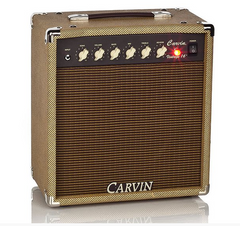-
Audio
-
Guitar
-
Bass
-
Blog
-
SALE
- Financing
- Support
- SINCE 1946
April 04, 2016

All practical audio amplifiers require some type of amplifying device, whether in the form of new school transistors or old school vacuum tubes. Transistor amps are durable, efficient and in lesser forms, comparatively inexpensive. Tube amps like power, they eat it like a college student making a fifth run at the "all you can eat buffet” while being fragile compared to their solid state cousins. Let’s not forget to mention the heat generated by tube amps. Your studio rarely needs that radiator to work on those cold nights while you are honing your craft.
So, why put up with the heat, the inefficiency and the expense of replacing tubes? Because you finally found that tone, the one that you were searching for that seems only a tube amp can produce.
There are as many myths and opinions about tube amps, as bad and usually unsolicited advice on how to maintain your investment. Some of this advice can actually damage your amp. Let’s dispel some bad information and give you a solid and simple advice on how to extend the life of your tube amp.
What is Going on Here?
A vacuum tube, sometimes called a “valve”, modulates power from a power supply to match your input signal to output a stronger or amplified signal. To do this it needs a filament, think incandescent bulb, to motivate this action, controlled by a grid, think gate keeper, to control this action between the cathode and the plate. Without proper operation between the cathode and grid, the tube can run wide open, simply burning up or can run cold by not allowing not enough through.
Pre-amp tubes, typically triode types like 12AX7s or the more rare 12AT7s, do not need to be re-biased in the amplifier when they are changed. When changing these you can simply plug in the new tube and you are ready to go.

For power amp tubes like EL34, 6L6, EL84, and 6V6 to operate correctly they typically need to be biased. These are usually in a push pull AB amplifier topology. To correctly operate the grid needs to “shut off” when the signal is switching to the other tube in the circuit. This is what the “push pull” term means. These are usually in even quantities because one half is sharing the work with the other half. There is an optimum bias DC voltage that needs to be applied to function correctly to reduce distortion and optimize power output.
Make sure your tubes are correctly biased, too high and hot, means they will die prematurely. Too low and cold and your sound will actually sound cold and lifeless. When working with a new rig, your life is simple because it should already be biased correctly. When using an older amp with non-specified replacement tubes, take it to a technician and have it re-biased with new tubes.
Note – Use the same tubes as the originals when replacing expired ones. It is always best to have your amp re-biased when replacing the power amp tubes. Again the pre amp tubes do not need to be biased. Note some matching systems claim using the same matched numbered tube does not require re-biasing. This is true in some cases and will work, but it is still best to check the bias. Only qualified persons should bias a tube amp. There are very dangerous high voltages present that can kill.
12 Habits to Extend Tube Life
Now that the basics are covered, time to cover a dozen good tube tips:
October 02, 2025
Discover the features and performance that the WG6 Wireless Guitar/Bass System has to offer. The WG6 Wireless Guitar/Bass System is designed to give you the wireless freedom you have been looking for and the simplicity to make your life as a working musician easier. Advanced wireless technology, multiple channel capability, premium audio processors make the WG6 the leader in compact wireless instrument systems. Defined and detailed low frequency response makes this system especially useful for bass players. The WG6 works with both active and passive instruments and is perfect for both electric and acoustic guitar/bass.
March 28, 2025
At any time at any gig, something is bound to go wrong and you may need a tool to get you back up and running. Here are a few basic tools you should bring to every gig.
January 09, 2025
I once asked blues legend Walter Trout why he still plays his well-worn vintage Strat. The technology exists to digitally scan the guitar and make very accurate replicas. His response was he could leave it at home, but then it will never be played. Plus, someone could steal it from his home. At least the guitar is with him and he has the pleasure of playing it. But this may not be the same for everyone.
Sign up to get the latest on sales, new releases and more…
NoFraud Frequently Asked Questions
"Make a joyful noise unto the Lord all of the earth; make a loud noise and rejoice and sing praises. Sing to the Lord with the harp and the voice of the psalm." - Psalm 98:4-5
© 2025 Carvin Audio.
Carvin Corp.
POS and Ecommerce by Shopify
